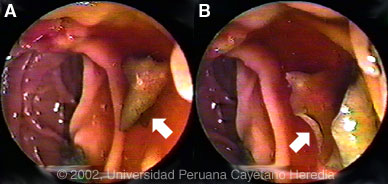2002 Case #6 |
 |
|
2002 Case #6
|
 |
|
| (Links to Other 2002 Cases are at bottom of this page) | ||
| Diagnosis: Chronic infection and dilatation of the common bile duct due to Fasciola hepatica. |
| Discussion: Fasciola hepatica is a trematode (fluke or flatworm) in which the adults inhabit the large biliary ducts. As can be seen from the endoscopic images from the CBD, the bile-stained adults are from 1-3 cm long and attach to the biliary epithelium by a single ventral sucker. A total of 5 adult worms were seen in this patient and we managed to aspirate one, which is shown by the white arrows next to the balloon (C) and laying on top of the balloon (D). The extracted fluke is shown on the right (E). Another fluke is shown superiorly in the bile duct (black arrows, C & D). In the absence of direct visualization, characteristic eggs can be seen on stool examination but more often, especially in the early migratory phases of infection, specific serology must be obtained.
 As with all other trematodes, Fasciola hepatica requires a snail intermediate host. Eggs produced by the hermaphroditic adults pass with the feces and hatch, releasing larvae in fresh water. After passing through a snail, mature cercariae emerge and rapidly encyst on various kinds of aquatic vegetation such as watercress (called berros in Perú). After ingestion by a human or animal definitive host, the metacercariae excyst in the duodenum and larvae pentetrate the intestinal wall and subsequently directly into the liver via Glisson's capsule. The larvae then migrate through the hepatic parenchyma until they reach large biliary ducts where they mature to adults. The distribution of Fasciola hepatica is cosmopolitan, but is by far the most common in sheep-raising areas where these herbivores are common definitive hosts. Heavily infected sheep develop "sheep liver rot". Other important definitive hosts are goats, cattle, horses, llamas, vicunas, and camels. The contiguous altiplano regions of the Peruvian and Bolivian Andes are highly endemic, with human prevalence rates of as high as 67% in some villages. Egypt, Cuba, and Northern Iran are also highly endemic. These are major sheep and camelid (llama, alpaca, vicuna, guanuco) raising areas where the human populations are heavy consumers of uncooked watercress. Cooking, which would kill the metacercariae, dramatically changes the flavor of watercress and the population is reluctant to adopt this simple measure. Clinically, the disease can be divided into acute and chronic phases. In the acute phase, migrating larvae cause inflammation and necrosis of hepatic parenchyma during the 3-4 months it takes to reach the large biliary ducts. High fever, eosinophilia, right upper quadrant pain and especially significant anorexia, vomiting and weight loss of 20 kg or more may develop, which usually abates when the larvae mature to adults. However, this phase may also be asymptomatic in some cases. As the adult flukes live for 10 years or more, it can be hypothesized that in our patient the episode 4 years ago that led to a cholecystectomy may have represented the acute phase of infection, even if stones had been present in the gall bladder on ultrasound at that time. The adult flukes in the biliary tree are generally asymptomatic but some patients develop chronic manifestations including right upper quadrant pain, nausea, vomiting, and hepatomegaly. Eosinophilia and abnormal liver function may develop but are less common than with acute disease. Adult flukes may cause hyperplasia, desquamation, thickening, and dilatation of the bile ducts. Malignant degeneration and cholangiocarcinoma such as results from chronic infection with the oriental liver fluke Clonorchis sinensis has not been reported with Fasciola hepatica. Fasciola hepatica is the only trematode infection for which praziquantel is not the drug of choice. WHO has put the veterinary anthelmintic triclabendazole (Novartis) on its essential drugs list and has declared it the drug of choice despite the fact that human preparations are registered in only 2 countries. In Perú, the veterinary preparation is readily available and used. In the U.S. and many other countries the veterinary preparation can be obtained by special release from the manufacturer. The usual dosage is 10mg/kg with a meal. Many practitioners repeat the dosage 12-24 hours later.
|
